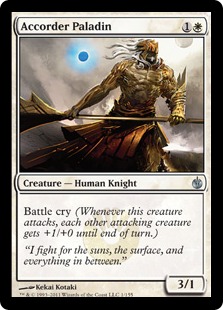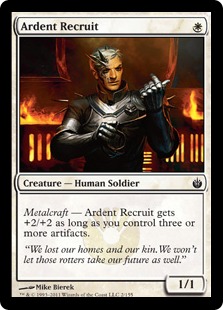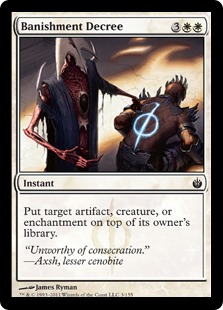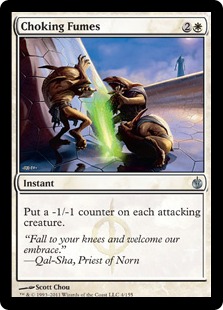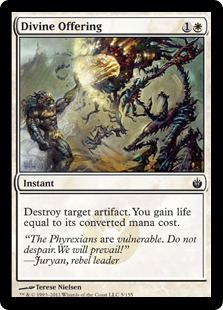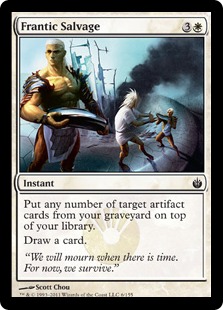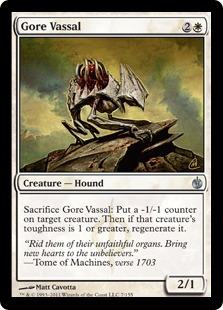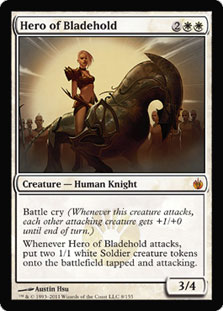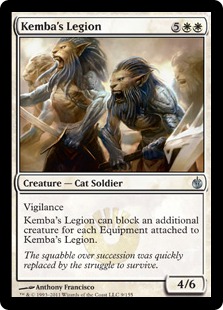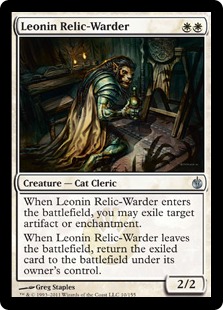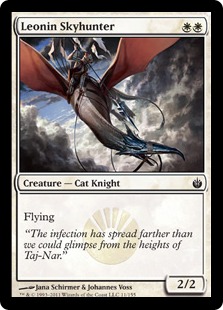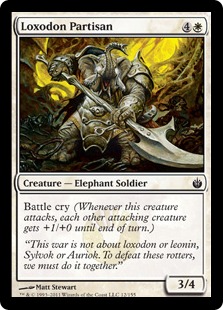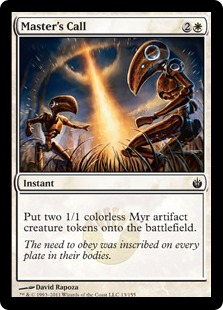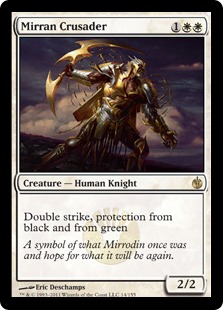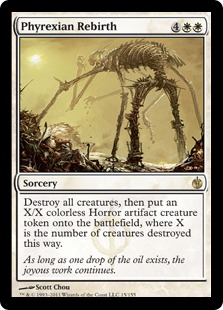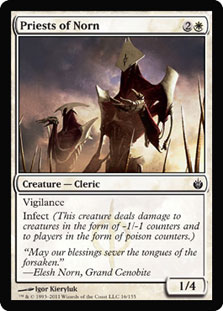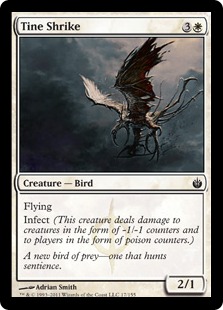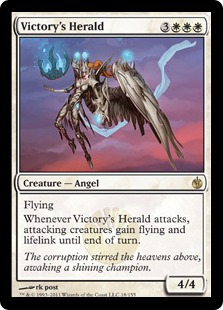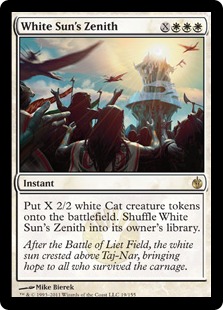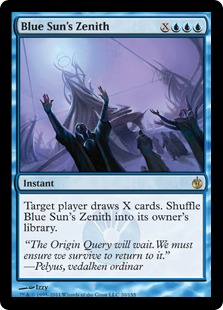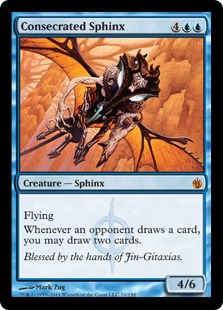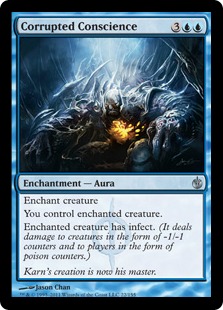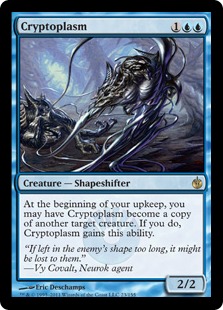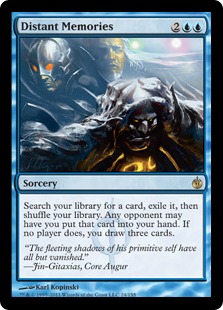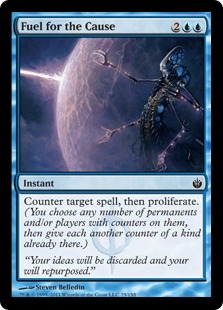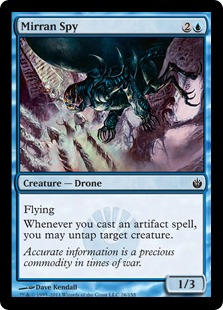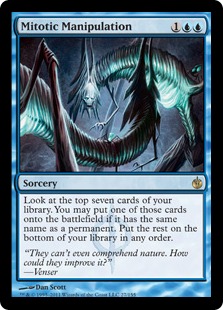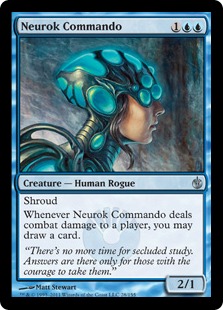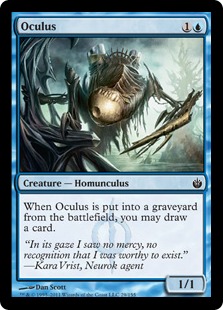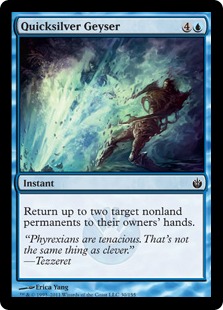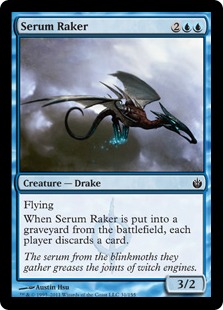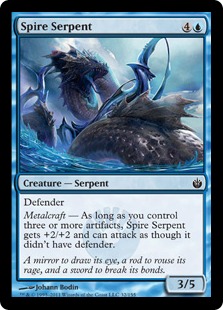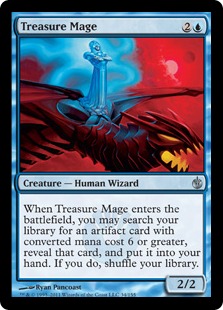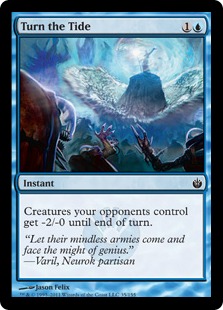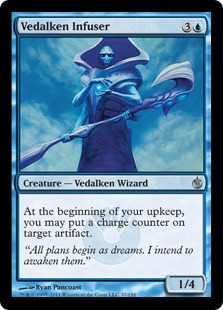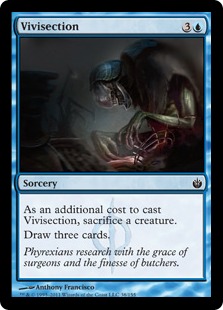This is part 4 in my Mirrodin Besieged set review. You can findPart 1 here, Part 2 here, and Part 3 here. Today, we
will cover white and blue cards. Let’s jump straight in!
White
After the obligatory power creep reference, we can move straight into discussion of exactly how good battle cry is and how much it adds to a 3/1 for
two. Blade of the Sixth Pride would be of interest to some players, just to hit as hard as he does, but the battle cry ability is actually pretty
useful for those exact people, as it lets Accorder Paladin average out to somewhere around a 4/1. It might even average out to higher than that, but
it’s higher variance, so much of the time, he’s just a 3/1, whereas other times he may be the equivalent of a 6/1 (which might end up being overkill).
White has been in the market for a two-drop that’s good against everyone, and Accorder Paladin definitely delivers. He’s going to be quite vulnerable
to all sorts of removal, but he’s particularly amazing against non-interactive opponents that are just trying to do something big (Valakut, U/G Wave,
Shape Anew). I’m seeing a lot of play in Accorder Paladin’s future.
The metalcraft “Wild Nacatl,” if you will, Ardent Recruit is where he needs to be on numbers but unfortunately in Standard is fairly confined to a
White Weenie deck with a lot of equipment, which is generally the exact type of strategy that I’d recommend one avoid. It’s especially challenging to
fully take advantage of the Ardent Recruit because if you try to employ artifact creatures such as Memnite and Ornithopter to try to get your
metalcraft, you start wanting Tempered Steel, which unfortunately doesn’t power up the Recruit. This is certainly not a deal-breaker, but every bit of
synergy matters when you’re trying to convince yourself to play White Weenie.
The Extended landscape is much more promising, where it’s pretty easy to make Ardent Recruit into a Wild Nacatl early and without playing “bad” cards,
though still with non-zero negative synergy. If artifact aggro is a deck (which I think it is), then Ardent Recruit is a very worthwhile consideration.
Verdict: Role-player
About as versatile as Bant Charm but unfortunately as expensive as Acidic Slime. We can do a lot better than five-mana one-for-one removal, especially
considering the “drawback” of their drawing the card again next turn. It is an instant, which is somewhat unique for a card this versatile in white;
however it is unlikely we’ll want to pay this kind of cost.
A poor Day of Judgment alternative; the place where this could be considered is as a tool for one aggro swarm deck to combat another. I doubt it will
come to that, but stranger sweepers have been played.
A reprint that is almost as playable as it was 16 years ago. Even though this is an artifact block, planeswalkers help ensure that such a narrow
reactive card is primarily limited to sideboards. In the old days, we used to Divine Offering our Serrated Arrows when the counters were used up. I
suppose Tumble Magnet is sort of a modern analog, but three isn’t that much life, and we aren’t that desperate. The use I’d be more interested in is
Divine Offering our own Spine of Ish Sah. That’s hardly game-breaking or anything, but it’s not bad.
Verdict: Niche sideboard option that will take over some of Revoke Existence’s action (though not all). In Standard right now, exiling the artifact
matters little unless some sort of Blightsteel Colossus deck takes off. The ability to hit enchantments is nice, but gaining life and, more
importantly, being an instant are both awesome against Argentum Armor.
This type of effect with creatures has hardly ever been played at three, so four is extremely unlikely. Possible uses include some theoretical combo
that sacrifices a lot of artifacts in one turn or in conjunction with some card that rewards you for knowing the top of your library. Unlikely to see
serious tournament play.
I haven’t seen this many purebred Hounds in one set since Odyssey! You’d have to value the body as at least a card and the -1/-1 (and regen!) ability
as at least a card to even consider the Gore Vassal (but even then, you’re not getting a good rate).
Hero of Bladehold is a chick I can get behind. When your deck is operating on all cylinders, she hits way harder than anything else you could
realistically play in a white aggro or midrange deck. Even if she comes to the party late, after everyone else has been judged, she wins the game on
her own very quickly. She’s certainly guilty of having no immediate impact on the board, no inherent card advantage, and no defensive abilities.
However, she’s like a 7/4 on her own that’s difficult to block and grows. Additionally, the tokens do stick around, which matters especially if you
draw a removal spell for her.
Some players will combine the Hero of Bladehold with Knight Exemplar, for mondo combos, but it’s possible to go further off the deep end. Michael Jacob
has been ranting like a lunatic about Renegade Doppelganger + Cytoplasm + Hero of Bladehold (the natural 20 on turn 4!). Of course, he’s bat-$%!t
crazy. An interesting advantage of Renegade Doppelganger and Cytoplasm is that they both turn on Knight Exemplar, to some degree. Yes, there’s no
shortage of people willing to tell us that she’ll just have her throat gotten, but remember the Baneslayer axiom: they don’t always have it!
Besides, it’s not like Go for the Throat wasn’t gold against you already.
Verdict: Role-player. White has been in the market for a four-drop ever since Elspeth changed her name, and Hero of Bladehold has a somewhat surprising
fourth point of toughness (normally these are the exact type of creatures that get screwed by Bolt).
Wouldn’t play it even at a Black Lotus discount.
Leonin Relic-Warder is a very exciting new addition to the “Hate-Bears Club.” His ability is somewhat in the same vein as Phyrexian Revoker, an ability
that you don’t want to count on but is quite disruptive for his duration on the battlefield. While he may not be the best fit for Standard, he’s better
the more powerful the format you play (and consequently the less removal other people play). In powered formats, he’ll often be able to stay on the
table and leave you just up a Revoke Existence while presenting a fine clock. One of the best Eternal cards in the set, sure to see tons of play in
tons of decks, as well as fringe play in lower powered formats (and possibly more play in Block).
Interestingly, Knight is actually a somewhat supported tribe, giving us additional reason to pause. Accorder’s Paladin and White Knight make for some
competition, but I imagine a dedicated Knight deck has room for more than eight two-drops. I think it’s unlikely that Leonin Skyhunter will get played
much outside of a Knight deck, though you never know. His body is not bad, and it’s possible that some White Skies deck will get invented that mostly
sticks to fliers.
Does not compare well to Hero of Bladehold.
There are a lot of interesting components to this deceptively complex card. The most important attribute is that the tokens are artifact creatures.
This lets us achieve metalcraft easily, as well as receive buffs from Tempered Steel and Steel Overseer.
A spell that produces two artifacts means that along with Inkmoth Nexus, we have the tools to build a Shape Anew deck with Blightsteel Colossus. The
fact that Master’s Call produces two tokens means that it can also be used to combo with Mass Polymorph or possibly some token-based strategy (though
at a relatively mediocre rate).
That the tokens are Myr means that this is sure to be a key component of any dedicated Myr deck. Myr Galvanizer, Myr Reservoir, Myr Turbine, and Myr
Battlesphere are all reasonable incentives to entice us into going all-out tribal. Additionally, Tempered Steel is a natural fit in such a deck, and
all of these cards are Block legal.
Master’s Call being an instant is particularly exciting for surprise metalcraft, as well as making blockers out of nowhere or setting up a turn 4 Shape
Anew without any warning.
Verdict: Role-player
This is a strange card that’s really not that much like Paladin en-Vec, a card that really preyed heavily on opponents that could not remove it at all.
Pro-green instead of pro-red is obviously a massive downgrade; however double strike instead of first strike is just bananas. Instead of looking at
this card from Paladin en-Vec shaded glasses, let’s just look at how sweet a 2/2 double striker is for 1WW with pro-black. Already, I’d be interested.
The pro-green is just gravy and will probably prove more valuable than meets the eye.
It’s unfortunate how poorly Mirran Crusader matches up against Jace, the Mind Sculptor and Lightning Bolt (two very popular cards, to be sure), but he
definitely works very well with Signal Pest, Accorder’s Paladin, Knight Exemplar, Hero of Bladehold, Honor the Pure, Ajani Goldmane, Contested War
Zone, and any equipment. He probably won’t get the spotlight, at least at first, on account of his vulnerabilities to the most popular cards, as well
as to every sweeper ever. Still, he has enough stats that he’s worth keeping in mind whenever you have equipment or are named Paul Rietzl.
Verdict: Role-player
This is a very interesting Day variant for a number of reasons. First of all, there are plenty of decks and matchups where one would want more than
four Days. Second, the body that’s left over is very relevant. It isn’t just that you’re getting a 4/4 creature (or whatever); it’s that it’s a cantrip
(not costing you an additional card beyond the Phyrexian Rebirth), and it only costs you two mana (over the cost of a Day).
When viewed in terms of just raw value, there’s no question the Phyrexian Rebirth is a hit. Wafo-Tapa is sitting next to me, here in France, and just
remarked that it’s definitely an upgrade to Sunblast Angel in many Standard decks. Of course, then he went on to say that he doesn’t really like
Sunblast Angel that much, right now, so take that for what it’s worth.
The real hurdle in the way of Phyrexian Rebirth is that the matchups where you want Day, you really want it turn 4. However, Phyrexian Rebirth
is the second Day of choice, so if you’re trying to turn into a six-Day deck, a couple of these will really help you put away all those aggro decks
(not to mention surprise an Avenger of Zendikar). Outside of occasional maindeck play in Standard (it is the wrong type of thing for Extended right
now), it’s definitely going to see a fair bit of sideboard action and a ton of Block play.
Verdict: Fringe maindeck, niche out of the board, and staple in Block.
A fine Limited card but cannot compare to cards like Phyrexian Crusader. He’s white, which is somewhat unique among infect creatures, but I doubt it
will be an attribute we care about.
Flesh-Eater Imp is going to have a tough time making the cut in Constructed, so Tine Shrike seems extremely unlikely unless you just really need white
infect creatures for some reason.
Victory’s Herald is a pretty sweet card but unfortunately suffers from both “doesn’t affect the board, doesn’t generate inherent card advantage, and
has no defensive abilities” syndrome and “costs the same as Titans” disease. This feels pretty win-more, sort of the white Consecrated Sphinx. Will
primarily see play in the casual circles; it’s possible one could just really want a budget Baneslayer (or a Baneslayer if/when Baneslayer rotates out
in M12).
While I think the Green Sun’s Zenith is definitely number one, it’s unclear which will come out ahead between Black Sun’s Zenith and White Sun’s
Zenith. The White Zenith is truly awesome on numbers, capable of turning the tides in the mid-game or outright winning the late game. The biggest
limiting factor is actually just that white’s options for “big games” are already amazing. Sun Titan, Baneslayer Angel, Gideon Jura, Elspeth Tirel,
Sunblast Angel, Phyrexian Rebirth, and plenty of artifacts make for steep competition for heavy white cards. Despite all this, White Sun’s Zenith is at
such a good rate that it will muscle its way into that crowd. In Standard, I have it currently above the Baneslayer, Sunblast, the Rebirth, the Sun
Titan, and Elspeth Tirel but below Gideon.
Blue
Blue Sun’s Zenith is actually an upgrade to Stroke of Genius in some Eternal decks that have absolutely no issue with the color requirements, such as
Time Spiral. In such a deck, being able to reshuffle the X-spell back so that you can now retrieve it with the Merchant Scroll you just drew is
worthwhile, as is having a shuffle for Brainstorm. The difference is minimal, but in some decks, it will be a clear upgrade.
As for Standard, Blue Sun’s Zenith is pretty slow and unwieldy. White Sun’s Zenith seems quite a bit better in U/W, just mana-for-mana. We might
actually consider it in U/B, though my hunch is that Jace’s Ingenuity is probably better (a card that generally isn’t good enough, as we end up just
using small Jaces instead).
Verdict: Niche in broken combo decks.
You know I want this guy to be good, but the truth is he’s probably exactly what he looks like: “Classic Win-More.” There’s definitely a part
of me that tries to rationalize the Sphinx by imagining that whatever answer my opponent has might be sorcery speed, which would give me at least two
cards off top. The sad fact is that Consecrated Sphinx is an expensive card that doesn’t immediately impact the board, provide inherent card advantage,
or have defensive abilities, plus he costs six, so the competition is at its fiercest.
Call me crazy, but I think there’s actually hope for the Consecrated Sphinx, and that hope is that he’s a 4/6. That toughness at least has a bit of
defensive ability to go along with his immediate, inherent card advantage (if they don’t have an instant).
Verdict: In my dreams, this card is fringe.
I’m really just not at all sure how to feel about this card. Let’s set aside Block for a moment where it might just be sick because it’s in such a
shallow pool. How good is this card in Standard? What if you play a U/B Infect deck? Five is kind of pricey for Control Magic, but double strike is
definitely a good thing to have; if you’re playing an infect deck, it makes the creature relevant to your attack. I’m not sure if the creature
enhancement aspect will matter enough, but we aren’t exactly paying extra for it, so it seems like a reasonable option to have. If a U/B Infect deck
exists, this is probably a worthwhile option, though not likely to have a big impact on any format. Even Block, where it’s a little ahead on power,
seems more likely to be dominated by planeswalkers than creatures.
A very cool Vesuvan Doppelganger with a much more appealing casting cost, it is easy to dismiss Cryptoplasm, but that’s probably a mistake. While it
doesn’t copy “enters the battlefield” abilities, a two-mana discount is pretty significant. As we mentioned earlier, Renegade Doppelganger +
Cryptoplasm + Hero of Bladehold is the turn 4 natural twenty that has MJ’s heart all aflutter. To really abuse Cryptoplasm in Constructed, we’d
generally want to explore creatures that have incredible synergy with themselves. How this will work in execution, I’m not sure, but he definitely has
chances at fringe play. He’s probably too much of a Gray Ogre to just get played “because he is good.” Not copying “enters the battlefield” triggers is
a major strike against him.
This is one of the rare few cards that’s just unspeakably bad, yet looks so good to so many players. It’s a trap! Do not fall for it! You like
Demonic Tutor? You like Ancestral Recall? That’s not what’s going on here. This isn’t even Diabolic Tutor or Concentrate. Maybe if this card cost
three, like Browbeat, I might be listening. Think of it this way; Distant Memories is just like a blue Diabolic Tutor for four (which would be
terrible), but then it has this major drawback where your opponent can exile the card you want and force you to draw three.
Wait, you might be saying, what if they make you draw three – isn’t that good? No! If your opponent is competent, the only time they’re going to
make you draw three is if drawing three isn’t as good as the Diabolic Tutor that you just showed them. I have no doubt this card will be fun in various
casual games, but avoid it like a cliché.
A cute card, especially when viewed as a cantrip in decks where proliferating is ideally worth a card. Unfortunately, proliferating is the type of
thing you generally want to do relatively quickly, and counterspells are rare enough these days that you generally want to be able to hold them for the
spells that really matter, making Fuel for the Cause a little clumsy. Additionally, it’s just such a nightmare to have Fuel for the Cause in hand,
three land on the battlefield, and an opponent’s Jace, the Mind Sculptor on the stack.
Verdict: Unique enough effect that it could possibly have a niche, but the realist in me is skeptical that it will pan out.
Mirran Spy has nowhere close to a good enough rate to hook us, so we’re forced to consider its somewhat unique effect, which is actually a bit of an
open-ended engine, albeit a poor one. Here, the joke is that we get “paid” a creature untap every time we can cast an artifact spell, so if we can get
a creature untap to be worth that and more, we have a loop. For instance, if you had two Sensei’s Divining Tops and a Palladium Myr, you would have a
loop that produces as much colorless mana as you like. That particular combo isn’t all that competitive, but it demonstrates the line of thinking that
would likely be used if Mirran Spy was actually somehow Constructed playable, as Drones are about as well supported as Hounds.
Verdict: Almost surely not what we want but a unique enough effect that hard-core Johnnies have something to explore.
Ahh, the blue Rampant Growth, so named because of the promise of getting at least an Island on turn 3 when playing a deck filled with Islands.
Then, as the card’s PR agents are quick to tell us, you can later use the card as a sort of Clone variant or as an answer to opponent’s Jaces.
There are actually two blue Rampant Growths: Everflowing Chalice and Sphere of the Suns. This is a blue Untamed Wild. As a bad Clone, it’s definitely
bad, and as an answer to Jace, that’s nice out of a Rampant Growth variant, but we could do leagues better. Besides, even if we magically wanted to
play mono-blue, we’d want fetchlands to shuffle, Tectonic Edges for defense, and at least one other type of non-basic. Besides, it really seems likely
that we would want at least another color.
If Mitotic Manipulation is to have a chance, I think it would actually have to have bigger ambitions. Bad Clone, Jace killing, and Untamed Wild are not
strong enough uses. Mitotic Manipulation’s ability to copy noncreature permanents is relatively unique, and three is not a great cost for such an
ability. If we somehow had a very powerful, noncreature permanent that was technically “on the battlefield” or that was going to sacrifice itself at
the end of the turn and that we couldn’t use, this could be a powerful way to “be able to use it.” It’s unlikely such a card exists now, though it
might, or it might get printed at some point. For now, I’m not impressed, but it’s unique enough to not be unplayable.
There sure seems to be a lot of hate for the Neurok Commando! Yes, I get that there are a lot more creatures these days, not to mention random Walls of
Omens or Sea Gate Oracles or Lotus Cobras or whatever, but this is actually a pretty sweet collection of abilities. He passes the Jace test with flying
colors. He’s still an Ophidian. He has a defensive ability. He seems tailor-made for certain niche sideboard situations.
Elvish Visionary has certainly seen play, and Oculus isn’t that far away in power. Still, death triggers are about half as good as “enters the
battlefield” triggers in general, and the Homunculus tribe isn’t quite as well supported as the Elf tribe. If you’re in the market for a blue creature
to sacrifice, he’s an option, but you’d have to be pretty desperate. If you were sure that opponents would be attacking you with 2/1s and 3/1s, you
might consider him as a defensive option, but it’s extremely unlikely that you couldn’t do better.
Designed to be traded in combat with pesky 1/1 infect creatures in Limited, if you ask me…
One of my favorite Limited cards in the set, Quicksilver Geyser combines many of my favorite things to do in Magic: make open-ended decisions, bounce
things, be tricky, and feel like I’m casting multiple spells.
As for Constructed, by the time you can cast Quicksilver Geyser, many of the expensive creatures that would be ideal to “blowout” are fairly immune to
it, as they likely have “enters the battlefield” triggers or defensive abilities. As a solution to problem permanents, it’s less easy to wield, less
efficient, and less versatile than Into the Roil. I’m not seeing this bursting out, but if you absolutely need to bounce two cards at once, no matter
the cost, it might be the best at that in some formats.
While certainly not the worst creature on paper, Serum Raker is unfortunately at the ultra-competitive four-spot on the curve, even having a casting
cost of 2UU. As we’ve learned from Conundrum Sphinx, a 4/4 for 2UU with upside is fringe at best, these days. This makes Serum Raker not close, at
least for Standard. Could someone build a Block Skies deck that would actually pay this kind of mana? I doubt it, as he doesn’t even have the decency
to hit for his power in damage. The Block format is likely to be dominated by planeswalkers, and Serum Raker is miles away in power. His somewhat
unique ability is very minimal, thus requiring mental gymnastics to conjure the scenario where you’d want to pay for it.
In draft-o? Obviously a sicko! The ability will generally be mostly symmetrical, but a 3/2 flier for four sounds fine to me.
While we can be assured of generally having metalcraft by the time Spire Serpent is online, we still just get a 5/7 vanilla for five mana, which is
nowhere near good enough. We live in a world where Baneslayer Angel is fringe! (Or perhaps just poorly positioned, as a result of Jace, the Mind
Sculptor and Primeval Titan). Of course, in Limited, this guy is sweet! In the early and mid-game, a 3/5 defender can be quite reasonable, and the
ability to turn into a true dinosaur makes this one a hit.
Now this is a spell I can get behind! Let’s start with Eternal, where this card is sure to have an impact. Bouncing a Null Rod, Chalice on
two, Smokestack, or other locking component for just a single mana is huge, giving you that window to be able to “go off.” Additionally, you can bounce
your opponent’s Blightsteel Colossus (even though it is turn 1) or your opponent’s Time Vault in response to his activation of Voltaic Key. Sometimes
you just need to buy yourself some time against Lodestone Golem, especially if you can Wasteland his Mishra’s Workshop. On top of this, you can even
use it as a relatively efficient way to protect your Time Vault from destruction, net mana with Mana Crypt or Mana Vault, build storm, or cycle it off
of a Sensei’s Divining Top.
The counter ability is fantastic for a variety of reasons. First of all, Annul was already a playable option, and while this cannot hit Oath of Druids,
Necropotence, or Bargain, it does have much of the same countering ability. The ability to almost always trade this in for a spell helps justify
playing multiple copies maindeck (yeah!). One of the subtly important aspects of this card is that the two abilities are both things you want, but if
you played a card that just did one, you’d get stuck some of the time. For instance, Annul is terrible once you’re behind. Chain of Vapor, meanwhile,
is no good against a Chalice on one and less good against a Trinisphere. Steel Sabotage is one of the best Eternal cards (primarily in Vintage) in the
set, and at a single blue mana has the casting cost of champions.
As for modern formats, the cost is still right if you’re in the market; however a substantially smaller quantity of artifacts gets played and by less
opponents. Could have uses, as the price is so good, and the card so versatile, but these aren’t really things that we expect to need or want, right
now.
Trinket Mage’s brother, Treasure Mage is also likely to be prone to toolboxes, though extensive six-plus-cost toolboxes are tough to fill. As a result,
we’ll likely see less 4x Treasure Mage than we saw with Trinket Mage. My favorite Treasures, thus far, are Spine of Ish Sah, Wurmcoil Engine, Contagion
Engine, Myr Battlesphere, Steel Hellkite, and Mindslaver. These are some really interesting cards to be able to get, though playing all of them is very ambitious.
Treasure Mage comes at a good rate, and while cheap spells are generally more likely to be cards we want to play anyway, Treasure Mage does give us
enough good options that he’ll see a fair amount of play. One nice aspect is that expensive spells like these are often exactly the types of cards you
don’t want to draw multiple copies of but that you want to be able to play on turn 5 or 6. Treasure Mages helps make this possible. He probably won’t
have as big an impact on higher-powered formats as Trinket Mage, but he’s a nice one for low-powered formats.
As a Fog variant, Turn the Tide is pretty terrible, so we’re forced to consider using it in creature combat to gain an advantage. Yes, our blue deck
with creatures designed to engage in creature combat is using a two-mana combat trick to try to gain a slight positional advantage… Alright, let’s be
serious; this is a niche Limited trick that will likely always be available to us during the draft and be somewhat tricky to use but probably a bit
underrated. At only two mana, the cost is actually quite reasonable, and if you think you can get two mana worth of value out of it (which is a very
reasonable thing to think), then go for it.
Since Vedalken Anatomist has a terrible rate, both in terms of body and as “removal,” we turn to his relatively unique abilities. Of these, untap is
traditionally the most abusable, though we must also consider the merits of giving a -1/-1 counter to a creature, which can, in some circumstances, be
an advantage. The resulting meshing of wonky effects is probably best suited for some sadistic, uber-Johnny Commander deck where one sets up some crazy
combo that no one sees coming and that they only ever get to pull off once. That one time will be enough, as the game will know that in that one
moment, they had been gotten.
I’m definitely looking forward to playing this card in Limited, however, as it is versatile, fun, and has a lot of play to it!
Yet another horrible rate, we’re forced to consider how to abuse him as a Tome. Unfortunately, a single charge counter on an artifact requires a lot of
work to even be worth a card, and a four-mana 1/4 would pretty much have to make a card’s worth of value to have me interested. If Vedalken Infuser
finds a home, it’s obviously in some sort of deck that finds a way to make charge counters worth a card. The issue I have with this possibility is that
even if that world exists, there are a half-dozen proliferate cards that do this better.
To be fair, Vedalken Infuser is for Limited, where he can be pretty sweet. A 1/4 for four is actually not the worst, and the ability to keep charging
our Tumble Magnet or Trigon or Necrogen Censer or whatever makes him an excellent addition to tons of decks.
Not a half-bad rate, I could actually see Vivisection finding a home in some sort of pseudo-combo deck that needs card draw to fuel its engine. We can
probably do better, but this is certainly worth considering, especially if you play cards like Viridian Emissary. Four is a tough cost to compete with,
obviously, but there aren’t really a lot of good Concentrates these days, and this one can potentially have its drawback turned into an advantage. It’s
also kind of amusing that the rare Concentrate in this set is atrocious, while the common one with a “drawback” is actually worth thinking about. In
Limited, this card is excellent, as creatures like off-color Myr, Perilous Myr, and random dudes make fueling it easy, and card advantage is highly
desired in this format.
That’s it for today, so see you tomorrow as we conclude our review of Mirrodin Besieged!
Patrick Chapin
“The Innovator”


